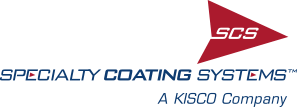<< View SCS Blog
All About Conformal Coatings
Conformal coatings insulate printed circuit boards (PCBs) and similar electronics; their protection increases devices’ tolerance to harsh environments. The result is undisturbed functionality through a range of frequently harsh operating environments and performance conditions. Conformal coatings are used to protect applications in the aerospace/defense, automotive, consumer and medical device industries.
There are five basic types of conformal coating. Four of the coating materials are applied to substrates by liquid (wet) methods; these are acrylic resin (AR), epoxy resin (ER), silicone resin (SR) and urethane resin (UR). Liquid methods are generally inexpensive and somewhat easy to use. The primary liquid application methods include:
- Brushing the wet coating onto substrate surfaces
- Dipping, or immersing, assemblies into canisters of liquid coating material
- Spraying the coating onto substrates
Parylene (XY) is the fifth major type of conformal coating. It uses a chemical vapor deposition (CVD) process for substrate application. Unlike liquid coatings, which cover surface areas only, gaseous Parylene CVD penetrates deep within substrate areas, creating a truly conformal, uniform and pinhole-free film. Providing generally superior conformal coverage, Parylene is a costly, time-consuming process compared to liquid coatings.
Comparing the Different Types of Conformal Coatings
Selecting a conformal coating requires careful analysis. Each coating material offers a unique blend of benefits and drawbacks that must be considered in relation to a given application.
Acrylic: Used primarily for moisture protection on PCBs, acrylic has traditionally been the least expensive and easiest conformal coating to apply. AR is a common conformal coating choice because it does not shrink during curing and provides reliable fungus/humidity resistance. Other AR advantages include:
- Easily removed for rework/repair
- Good dielectric barrier properties
- Long pot life
- Low glass transition (Tg) temperatures.
AR drawbacks:
- Limited solvent resistance
- Limited abrasive/stress-relieving properties
- Cost advantage/effectiveness has declined relative to competing coatings
AR is not an ideal solution for applications requiring higher operating temperatures, prolonged exposure to moderate/strong solvents and exceptional, longer-term coating strength.
Epoxy: With reliable abrasive, chemical and humidity resistance, epoxy films are applied similarly to acrylic and other liquid coatings. ER offers users these benefits:
- Exceptional surface hardness and service durability
- Good dielectric and moisture barrier properties
- High glass transition (Tg) temperature in comparison to most coatings
ER Drawbacks:
- Epoxy’s hardness and durability make it difficult to remove or rework if damaged
- Coatings shrink during polymerization
- Thermal extremes during operation significantly lower epoxy’s stress resistance
- Some lack UV trace
Silicone: Versatile silicone conformal coating can be customized according to a product’s precise requirements; surface treatments range from elastomeric, stress-relieving coverings to far more abrasion-resistant and durable coatings. SR is particularly suited for automotive applications because of its endurance in extreme, high-temperature environments. Its operating temperature range is -55°C to more than 200°C. Other benefits include:
- Excellent moisture barrier properties
- High humidity/UV/corrosion resistance
- High dielectric strength.
- Low surface energy, which promotes enhanced wetting
- Low dissipation factor
- Good adhesion to most PCB materials
- Rapid curing
- Thicker film applicability generates thermal protection and vibration dampening
- Easy application and rework
- Low toxicity
SR drawbacks:
- Poor abrasion/wear resistance
- Poor solvent resistance, compared with other conformal coatings
- Achieving optimal coating thickness requires more time and attention than other liquid materials.
Urethane: UR demonstrates exceptional chemical resistance, consistent dielectric properties and low moisture permeability. Available in single- or dual-component, UV-curable or water-based versions, UR is often the optimal conformal coating choice for PCB protection and applications that demand exposure to chemical solvents. Urethane conformal coating benefits include:
- Dependable abrasion/humidity/solvent resistance.
- Protects substrates from moisture and contaminants
- Offers durability/hardness, and wear resistance.
- Good temperature flexibility at low temperatures
- Mitigates tin whisker growth
- Facilitates miniaturization, insulating signal-traces situated in close proximity.
UR drawbacks:
- Slow cure
- Challenging removal/rework because of its solvent-resistant nature
- Unable to withstand high-vibration/high-heat environments
- Limited bond strength.
- Coating breakdown when used over larger areas
- Limited reparability
Parylene: CVD-derived Parylene conformal films provide are ultra-thin and provide excellent substrate coverage. Film consistency is exceptionally uniform and pinhole-free, preventing leakage. Parylene’s exceptional dielectric properties make it ideal for a wide array of electrical components. Benefits of Parylene include:
- Adhesion to a wide range of substrate geometries
- Can be applied and effective at sub-micron thicknesses
- Chemically inert
- Conformability and flexibility
- Excellent dielectric/moisture barrier properties
- High optical clarity.
- Tin whisker mitigation
- Penetrates extremely small spaces and crevices
Parylene drawbacks:
- More expensive, attributed to the cost of raw materials, labor and lot volume
- Limited throughput; batch process
- Sensitive to contamination
- Requires an abrasion-based method for removal
Optimal conformal coating use and protection is reliant on selecting the conformal coating type that best meets the performance needs and environment of the project. Carefully evaluating the benefits and drawbacks of the different types of conformal coating is a critical step in the selection process.

